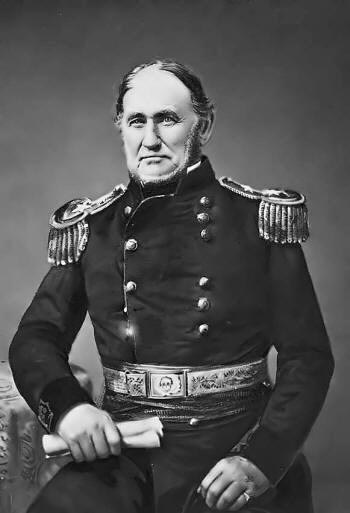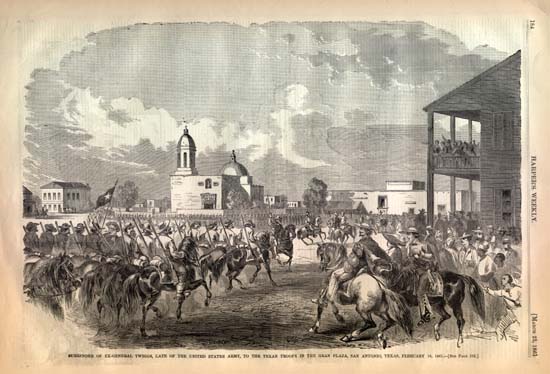General David Twiggs
![]()
This Site:
|
Twiggs, DAVID EMANUEL, military officer; born in Richmond county, Ga., in 1790; entered the United States military service as captain in the spring of 1812, and became major of infantry in 1814. In 1836 he became colonel of dragoons, and as commander of a brigade he distinguished himself in the battles of PALO ALTO and RESACA DE LA PALMA. He was made brigadier-general June 30, 1846, and was brevetted major-general for gallantry at MONTEREY. Twiggs commanded a division in Scott's campaign in Mexico in 1847, and in 1848 be was made civil and military governor of Vera Cruz. Early in 1861 he was in command of United States troops in Texas. General Twiggs had served his country honorably in its armies for forty years, but the virus which corrupted so many noble characters did not spare him. |
General David Twiggs |
|
He was a native of Georgia, and seems to have been under the complete control of the Confederate leaders. He was placed in command of the Department of Texas only a few weeks before the act about to be recorded. A State convention in Texas appointed a committee of safety, who sent two of their number (Devine and Maverick) to treat with Twiggs for the surrender of United States troops and property into the hands of the Texas Confederates. Twiggs had already shown signs of disloyalty. These had been reported to the War Department, when Secretary Holt, in a general order (Jan. 18), relieved him from the command in Texas, and gave it to Col. Charles A. Waite. When Devine and Maverick heard of the arrival of the order in San Antonio, they took measures to prevent its reaching Colonel Waite, who was 60 miles distant; but the vigilant Colonel Nichols, who had watched the movements of the general with the keen eye of suspicion, foiled them. He duplicated the orders, and sent two couriers with them, by different routes. One of them reached Waite Feb. 17; but the dreaded mischief had been accomplished. Twiggs had been cautious. He did not commit himself in writing; he always said, " I will give up everything." He was now allowed to temporize no longer. He had to find an excuse for surrendering his troops, consisting of two skeleton corps. It was readily found. Ben McCulloch, the famous Texan ranger, was not far off with 1,000 men. He approached San Antonio at 2 A.M. on Feb. 10. He had been joined by armed KNIGHTS OF THE GOLDEN CIRCLE near the town. With a considerable body of followers, he rushed into the town with yells and took possession. Twigg's Surrender to Ben McCulloch at the San Antonio PlazeTwiggs pretending to be surprised, met McCulloch in the San Antonio Plaza, and there, at noon, Feb. 16, a negotiation for surrender (begun by the commissioners as early as the 7th) was consummated. He gave up to the Confederate authorities of Texas all the National forces in that State, about 2,500 in number, and with them all the stores and munitions of war, valued, at their cost, at $1,200,000. He surrendered all the forts in his department. By this act Twiggs deprived the government of the most effective portion of the regular army. When the government heard of it, an order was issued (March 1) for his dismissal " from the army of the United States for treachery to the flag of his country." Twiggs threatened, in a letter to the ex-President, to visit Buchanan in person, to call him to account for officially calling him a " traitor." The betrayed troops, who, with most of their officers, remained loyal, were allowed to leave Texas, and went to the North, taking quarters in Fort Hamilton, at the entrance to New York Harbor. General Twiggs was then given an important position in the Confederate army, and was for a short time in command at New Orleans, resigning towards the close of 1861. He died in Augusta, Ga., Sept. 15, 1862. |
|
![]()
|
Site Copyright © 2003-2018 Son of the South. For questions or comments, contact paul@sonofthesouth.net. |
|
|
|
Are you Scared and Confused? Click Here to read My Snake Story, a story of hope and encouragement, to help you face your fears. |
||

